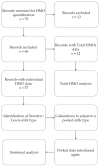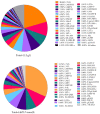The Mean of Milk: A Review of Human Milk Oligosaccharide Concentrations throughout Lactation
- PMID: 34444897
- PMCID: PMC8398195
- DOI: 10.3390/nu13082737
The Mean of Milk: A Review of Human Milk Oligosaccharide Concentrations throughout Lactation
Abstract
Human milk oligosaccharides (HMOs) are non-digestible and structurally diverse complex carbohydrates that are highly abundant in human milk. To date, more than 200 different HMO structures have been identified. Their concentrations in human milk vary according to various factors such as lactation period, mother's genetic secretor status, and length of gestation (term or preterm). The objective of this review is to assess and rank HMO concentrations from healthy mothers throughout lactation at a global level. To this aim, published data from pooled (secretor and non-secretor) human milk samples were used. When samples were reported as secretor or non-secretor, means were converted to a pooled level, using the reported mean of approximately 80/20% secretor/non-secretor frequency in the global population. This approach provides an estimate of HMO concentrations in the milk of an average, healthy mother independent of secretor status. Mean concentrations of HMOs were extracted and categorized by pre-defined lactation periods of colostrum (0-5 days), transitional milk (6-14 days), mature milk (15-90 days), and late milk (>90 days). Further categorizations were made by gestational length at birth, mother's ethnicity, and analytical methodology. Data were excluded if they were from preterm milk, unknown sample size and mothers with any known disease status. A total of 57 peer-reviewed articles reporting individual HMO concentrations published between 1996 and 2020 were included in the review. Pooled HMO means reported from 31 countries were analyzed. In addition to individual HMO concentrations, 12 articles reporting total HMO concentrations were also analyzed as a basis for relative HMO abundance. Total HMOs were found as 17.7 g/L in colostrum, 13.3 g/L in transitional milk, and 11.3 g/L in mature milk. The results show that HMO concentrations differ largely for each individual HMO and vary with lactation stages. For instance, while 2'-FL significantly decreased from colostrum (3.18 g/L ± 0.9) to late milk (1.64 g/L ± 0.67), 3-FL showed a significant increase from colostrum (0.37 g/L ± 0.1) to late milk (0.92 g/L ± 0.5). Although pooled human milk contains a diverse HMO profile with more than 200 structures identified, the top 10 individual HMOs make up over 70% of total HMO concentration. In mature pooled human milk, the top 15 HMOs in decreasing order of magnitude are 2'-FL, LNDFH-I (DFLNT), LNFP-I, LNFP-II, LNT, 3-FL, 6'-SL, DSLNT, LNnT, DFL (LDFT), FDS-LNH, LNFP-III, 3'-SL, LST c, and TF-LNH.
Keywords: 2′-fucosyllactose; HMO composition; human milk carbohydrates; human milk oligosaccharides; non-digestible carbohydrates.
Conflict of interest statement
All of the authors in the work are employed/were employed at the time of research at the company DSM Nutritional Products which produces and sells HMOs.
Figures




References
Publication types
MeSH terms
Substances
LinkOut - more resources
Full Text Sources
Other Literature Sources
Medical
Miscellaneous

